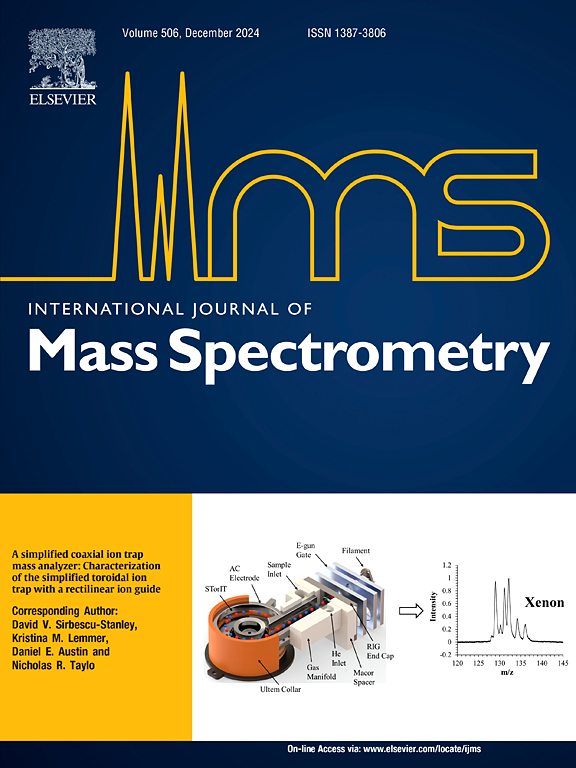Structural differentiation of protein charge state conformers via gas-phase ion/ion cross-linking mass spectrometry
IF 1.7
3区 化学
Q3 PHYSICS, ATOMIC, MOLECULAR & CHEMICAL
引用次数: 0
Abstract
Determining structures of multiply charged protein ions in mass spectrometry is critical for understanding the relationship between condensed-phase protein structures found in biological environments and gas-phase structures produced during electrospray ionization (ESI). The determination of collision cross-sections (CCSs) via ion mobility-mass spectrometry (IM-MS) has been used to study conformational changes as a function of protein charge state; however, this approach provides limited structural information on the overall topology of analytes. Recently developed gas-phase cross-linking mass spectrometry (XL-MS) performed via ion/ion reactions can probe local tertiary structures, providing an additional dimension to MS-based gas-phase structural biology studies. Herein, we demonstrate the conformational differentiation of alcohol-denatured, ESI-generated ubiquitin ions with varying charges (6+ through 11+) using gas-phase XL-MS. Gas-phase N-hydroxysulfosuccinimide (NHS) ester chemistry is performed using sodiated ethylene glycol bis(sulfosuccinimidyl succinate) (sulfo-EGS) cross-linkers to covalently modify neutral and charged basic amino acid residues. This method provides sufficient sensitivity to detect subtle conformational changes in local tertiary structures specific to each charge state. These results reveal that 6+ through 8+ charge states of ubiquitin adopt folded conformations, while the 9+ through 11+ charge states exhibit unfolded structures. This trend is consistent with the bimodal charge state distribution observed in the ESI mass spectrum of alcohol-denatured ubiquitin. Overall, this gas-phase XL-MS method enables the examination of conformational changes in gas-phase proteins of varying charge states at the local tertiary structural motif level, providing a novel gas-phase structural biology approach that complements existing MS-based methods.

气相离子/离子交联质谱分析蛋白质电荷态构象的结构分化
在质谱中确定多重带电蛋白离子的结构对于理解生物环境中发现的凝析相蛋白结构与电喷雾电离(ESI)过程中产生的气相结构之间的关系至关重要。离子迁移-质谱(ion mobility-mass spectrometry, IM-MS)测定碰撞截面(CCSs)已被用于研究蛋白质电荷态的构象变化;然而,这种方法在分析物的整体拓扑结构上提供了有限的结构信息。最近开发的气相交联质谱(XL-MS)通过离子/离子反应进行,可以探测局部三级结构,为基于ms的气相结构生物学研究提供了额外的维度。在此,我们利用气相XL-MS证明了乙醇变性、esi生成的具有不同电荷(6+至11+)的泛素离子的构象分化。气相n -羟基磺基琥珀酰亚胺(NHS)酯化学是使用硫酸乙二醇双(磺基琥珀酰亚胺琥珀酸)(磺基egs)交联剂共价修饰中性和带电的碱性氨基酸残基。该方法提供了足够的灵敏度来检测特定于每种电荷状态的局部三级结构的细微构象变化。结果表明,泛素的6+ ~ 8+电荷态为折叠构象,9+ ~ 11+电荷态为展开构象。这种趋势与醇变性泛素ESI质谱中观察到的双峰电荷态分布是一致的。总的来说,这种气相XL-MS方法能够在局部三级结构基序水平上检查不同电荷状态的气相蛋白质的构象变化,提供了一种新的气相结构生物学方法,补充了现有的基于ms的方法。
本文章由计算机程序翻译,如有差异,请以英文原文为准。
求助全文
约1分钟内获得全文
求助全文
来源期刊
CiteScore
3.60
自引率
5.60%
发文量
145
审稿时长
71 days
期刊介绍:
The journal invites papers that advance the field of mass spectrometry by exploring fundamental aspects of ion processes using both the experimental and theoretical approaches, developing new instrumentation and experimental strategies for chemical analysis using mass spectrometry, developing new computational strategies for data interpretation and integration, reporting new applications of mass spectrometry and hyphenated techniques in biology, chemistry, geology, and physics.
Papers, in which standard mass spectrometry techniques are used for analysis will not be considered.
IJMS publishes full-length articles, short communications, reviews, and feature articles including young scientist features.

 求助内容:
求助内容: 应助结果提醒方式:
应助结果提醒方式:


